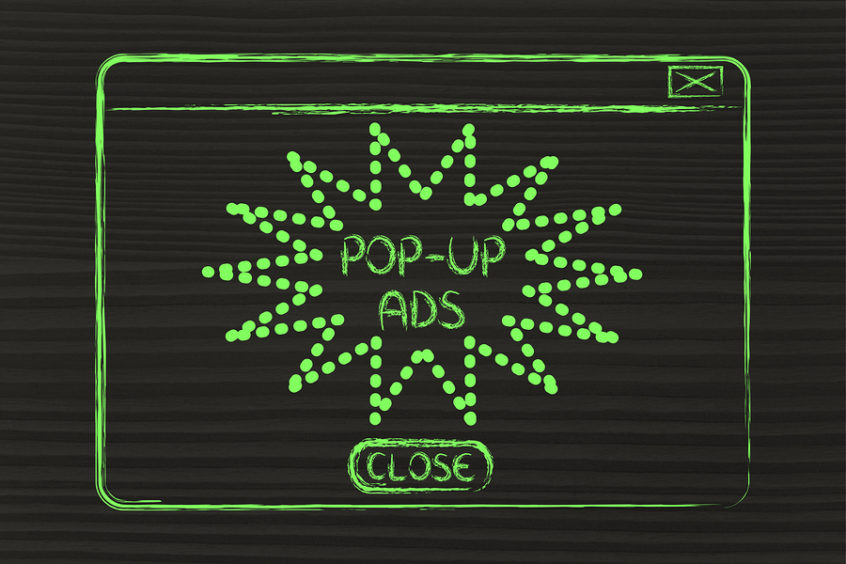This conversation comes up often when working with clients. They may have had one on their old websites or they have just returned from a conference and were told that they are amazing or they have a friend who says they need to have one. What I’m talking about is pop-ups.
On occasion, pop-ups have their uses, but often times they are more of a hindrance for clients then they are worth.
Pop-ups have been around for a long time. Pop-up ads were created in the late 1990’s by Ethan Zuckermann as a way to help online advertisers. Unlike banner ads, that often can be found on a variety of websites, a pop-ups intention was to keep an ad on specific page.
In theory, this is a benefit. You will have more control over your own, personalized advertisement to your clients. You can have them join newsletters and be a part of your contact list. You can push specific products and service deals at any time you need. It’s powerful functionality.
That being said, it often comes at a cost of hurting the user’s experience on your website. Pop-up ads often prevent the user from navigating a webpage unless they click the exit button, fill out a form, or click on the ad. It forces the user to stop and make a decision, usually at the worst time while on your website.
A pop-up is like a mall stand vendor. They “pop-up” throughout the walkways of the mall, asking you if you want to try their cologne/perfume, or buy their expensive new product that can be found on Amazon for half the price and twice the quality. Some of us stop and give it a try, while others keep walking by. The only real difference between the human pop-up and the digital one is the impact of time.
If I said no to a vendor or no to a pop-up, both take about the same amount of time. It takes seconds. However, when you are at a mall, you generally have more time. You’ve already committed to driving there, to parking, to walking the mall in search of the product or service you came to seek out.
Online, time matters. It takes seconds to grab my phone, click on my browser and start researching products. If a website is well-optimized, it takes seconds to move through a website to find what we are looking for. A website’s pop-up stops our progress and can easily catch us off guard. That one or two seconds lost can be detrimental to making a sale.
I know the title of this says I don’t recommend pop-ups, but really what I am saying is, “Pop-ups don’t work for most companies.”
Will you click on a pop-up if it gets you a discount on your purchase? Typically yes.
Will you give your email to sign up for a newsletter? Typically no.
Will you give your email and name if you get a really cool free item? Typically no, if the pop-up is on the first page or if it pops up right away when I get to the site. At this point, a user may not be fully sure what they are looking for. Getting in their face early makes people uneasy.
Now, if the pop-up is in the corner of a page that I am spending time learning about and the free item relates to the content I’m interested in? Maybe then you will get the user to click.
As mentioned earlier, pop-ups were a useful marketing tool, but the landscape has changed drastically since the 90’s. In 2019, Google has since cracked down on the usage of pop-ups and if they decide that it’s interfering with the user experience they will move your website down in the search engine rankings.
Google puts a focus on improving the user’s experience and, like others, have noticed how distracting and destructive pop-ups can be to a user’s experience on websites.
Google really dislikes:
- Pop-ups on the first page of mobile websites
- Pop-ups that hide the majority of the webpage when active
- Interstitial webpages: webpages before a content page
Pop-Ups are best used by:
- Large Retail Companies to promote their sales
- If your company is having a one-time sale on product
After everything I’ve presented, if you still want a pop-up it must follow this 5 key points.
5 Key Points for Having a Good Website Pop-Up
- Make sure the content is relevant to the page it’s on
- Only ask for their email
- Copy needs to be short and to the point
- Avoid first page pop-ups – privacy pop-ups are the only ones Google doesn’t hate
- Place in the right location
If it makes good sense to use a pop-up on your website, I will make that happen for you. My clients come first and I want them to be happy with their website, but I don’t want them to make a decision without knowing the drawbacks and disadvantages. Most of the time I will strongly suggest that you avoid pop-ups, considering most people avoid website pop-ups and I would hate to see you lose clients and your Google ranking.
I don’t typically recommend pop-ups because the negatives outweigh the benefits. It’s a situational tool and usually the short-term advantages have to be better than the long-term disadvantages in order for it to work effectively.
I hope you have all come away with some new knowledge about pop-ups, their advantages and disadvantages, and some ideas on how to better optimize your website. If you have any questions, please contact me at here.
